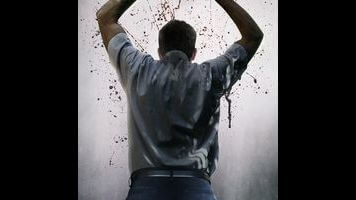The movie peaks during its opening stretch, which unfolds with a certain psychological plausibility. Finding themselves locked inside their workplace by a series of iron shutters that slam down over every door and window, the staffers of the Belko Corporation don’t instantly turn violent. In fact, they don’t even start offing each other right when the threat becomes real—which it to say, when a few employees are randomly sacrificed, their skulls blown open by the supposed “tracking devices” implanted in them by corporate. Instead, the bloodshed grows slowly out of polite discussion, snowballing from the coldly logical reasoning of company COO Barry (Scandal’s Tony Goldwyn). His chilling rationalizations are challenged by the film’s moral compass and voice of reason, Mike (John Gallagher Jr., doing another loose variation on The Office’s Jim Halpert, who he previously mimicked for three seasons on Aaron Sorkin’s The Newsroom).
The Belko Experiment fills its company directory with a sprawling cast of familiar faces and game character actors; at times, it uses the performers’ recognizability against the audience, subverting expectations. (Surely, the star of one of cinema’s most notorious serial-killer stories has been cast as the most vicious character, right?) The closest point of reference here is probably the Japanese cult favorite (and Hunger Games precursor) Battle Royale. But that movie played more extensively with the existing relationships among its unwilling combatants, who shared classrooms instead of cubicles. Belko hints at first that it might treat its carnage like an extension of office politics, but beyond making upper management the cold-blooded aggressors—with Scrubs alum John C. McGinley as the most remorseless of the lot, a budding psychopath in a tie and button up—the opportunity is largely blown. At a certain point, we could just be watching strangers kill each other.
Is it an uneasy collision of sensibilities that keeps the movie from settling on a consistent tone? Gunn, who wrote the screenplay years ago, specialized in a much nastier breed of genre fare before getting scooped up by Marvel; his tendency to treat sudden, hideous death as a dark punchline (see Super, or the Dawn Of The Dead remake, which he also wrote) gets a big workout in Belko’s periodic strings of exploding noggins. McLean, by contrast, tends to play extremity nightmarishly straight. Consequently, The Belko Experiment teeters between “fun,” gory brutality and a more seriously disturbing variety—the latter epitomized by the film’s centerpiece, a chillingly organized process of elimination that echoes mass shootings and historic Final Solutions in equal measure. After that crucible, who’s really in the mood to see someone get their face bashed in with a tape dispenser?

